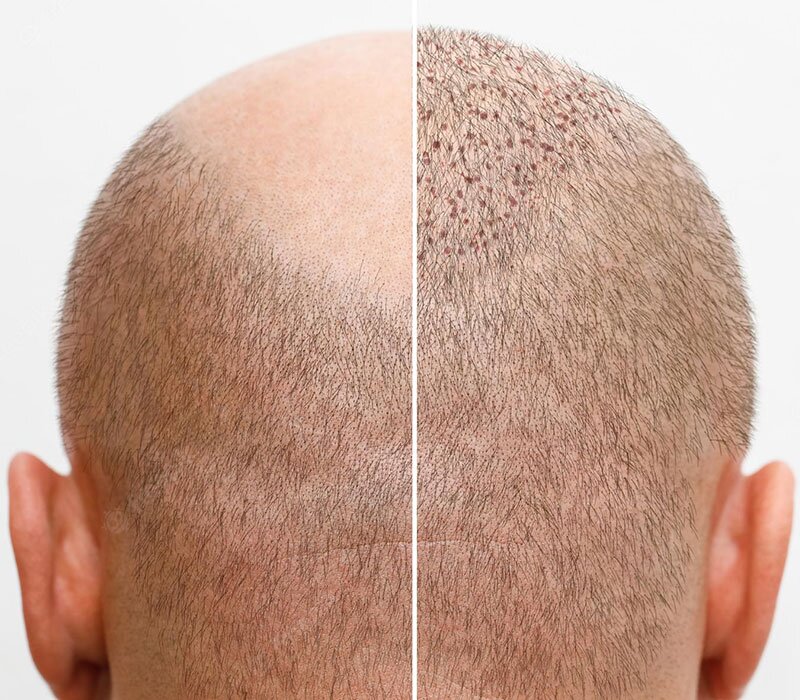Hair Transplant
A receding hairline reflects age. The commonest form of hair loss is determined by our genes & male hormones & hence called Androgenetic alopecia or male pattern alopecia. This can affect both males & females. Apart from the hormones, hair shedding can be because of improper excess combing, disease/deficiency or psychological problem and dietary deficiencies.
Hair transplantation is ideal way of restoring lost hair. It is not the treatment for hair loss and thinning for which medical treatment is recommended. The modern techniques for restoring hair are use of follicular, micro , mini and slit grafts, scalp reduction, slit grafts, scalp reduction, strip graft and flap procedure. Use of one or combinations of these techniques gives desirable and satisfactory result in suitable cases.
Follicular or single hair transplant are more and more common in use these days. This methods is known by the name FUE. This technique also gives best and natural results. The advantage being that this can be performed under local anesthesia on a day care basis and patient does not need hospitalization for this.

The treatment of hair loss as mentioned earlier is by medical therapy, but once the hair line starts to recede the only option left is Hair transplantation. The concept of "donor dominance" forms the corner stone of a successful Hair transplantation. This means that the hair on the back of the scalp (occiput) does not fall off, as they are devoid of the receptors on which hormones (testosterone) acts. These hair are thus grafted over the frontal region.

Frequently Asked Questions
It depends on the patient’s attitude towards his receding hair and his expectations. One should not wait till complete baldness before having a transplant. Frontal area transplant for receding hairline is most commonly performed in younger individuals who are not completely bald as yet. Second sitting may be added in future for more baldness patches as they appear.
The transplanted hair will grow for as long as the hair of the donor site from which it has been harvested. In most cases it will last a lifetime. But patient may experience thinning in density as the original hail continue to shed.
If more than one session is planned it is usually at 3 to 4 months intervals if the same area is being transplanted. With refinement in the technique usually one area does not require second session. Second session is mostly needed for separate area. If different areas are being treated the time interval may be much shorter. There is no maximum interval between sessions.
This is dependent on the size of the donor area. Mega sessions can be planned if donar area is sufficient. But it is usually safer to split sessions in two stages if the area is large.
Although the use of laser light as a scalpel for hair transplantation is used as a marketing tool, it is not a preferable method as the head generated by laser hampers in blood supply to the grafted follicles.
Hair loss can be camouflaged. Numerous methods exist to camouflage hair loss. Wigs and hair pieces differ immensely in cost, durability, maintenance requirements, and quality. Some are fixed to the skin with glue, others are simply placed on the head. Hairpieces should be chosen with care to ensure that the color of the hair matches, the hair has a natural texture and look, and it fits properly. The slightest discrepancy in any of these factors will make the hairpiece noticeable, and an obvious hairpiece looks far worse than a bald head.
Hair weaving is another camouflage option. In this method, hair, usually of human origin, is matched in color and texture to the individual’s own hair, then woven or knotted to it. This method works especially well in a small area. The advantage of hair weaving is that it stays in place during vigorous activity, as well as in the water. The disadvantage is that it requires frequent adjustments because as the hair to which it is attached grows, the knots loosen up, and the woven hair lifts away from the head. Irritation of the skin under the woven hair is common, whether or not the hair used is real or synthetic.
Schedule A Virtual or
Presential Appointment Today
Free Consultations! call +91-7291939393
Fill in our quick Appointment Form. We will schedule your Appointment.

